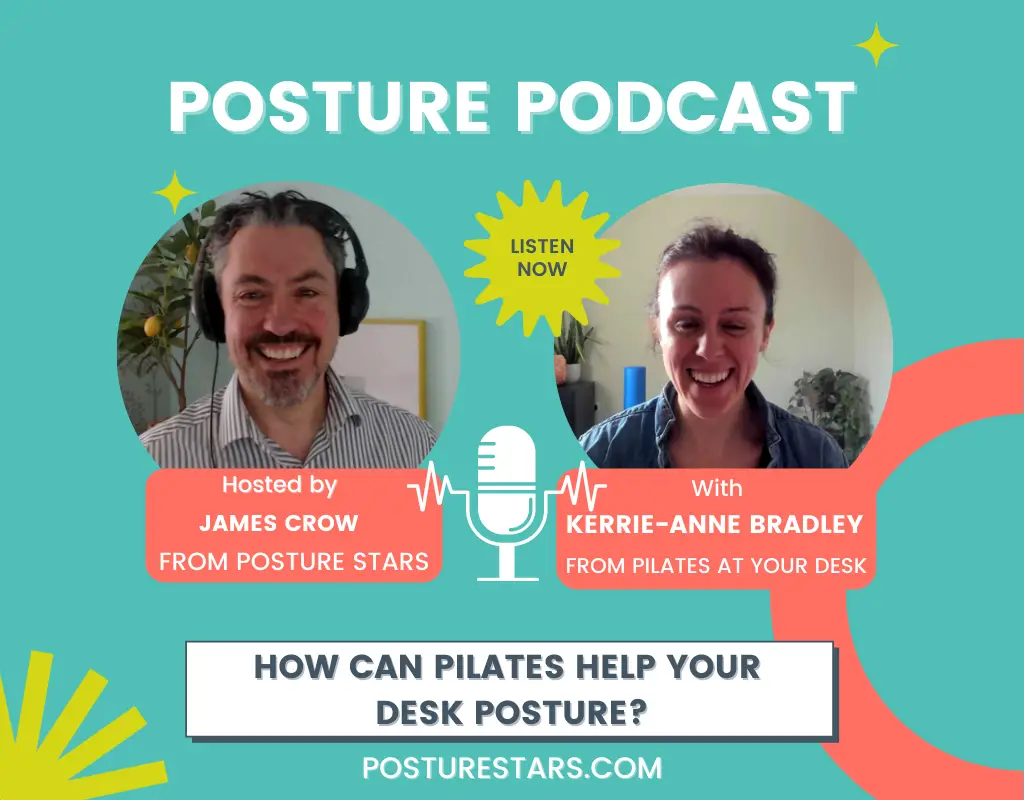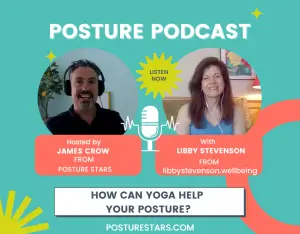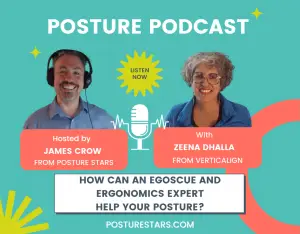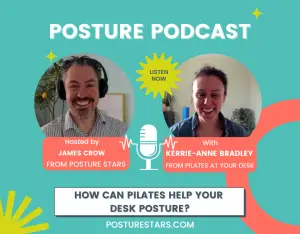Season 1 Episode 13
We talk to Kerrie-Anne Bradley from Pilates At Your Desk about the benefits of Pilates for desk workers. Let’s find out, can Pilates help your desk posture?
James Crow
Hello everybody, its James from Posture Stars. Thanks for coming back again. Today I’m really excited to be talking with Kerrie-Anne Bradley, from Pilates at your desk, who is an author, a Pilates instructor and works with corporate and individual clients to help them get moving at their desk. Good morning Kerrie-Anne. How are you today? You’re down in Summerfield in the south of England.
Kerrie-Anne Bradley
Somerset!
James Crow
Yeah, you’re not in a field at all are you, you’re in Somerset.
Kerrie-Anne Bradley
But it looks nice. I just haven’t been outside yet.
James Crow
It’s always a good idea to get outside. To our listeners, if you haven’t been outside yet, get outside and get some fresh air. Don’t just sit there at your desk, make sure you get moving. Which brings me rather neatly in terms of getting moving to, you’ve just released a book. Is that right? Kerrie-Anne?
Yes, Move More At Your Desk.
Brilliant. So those of you listening to this, if you’re at your desk, we’ve got some good advice for you later. I’ve got three simple questions to ask Kerrie-Anne in our series about posture. So let’s get going. Question one Kerrie-Anne. What is posture?
Gosh. So to me, I like to think about posture as how you organise your body in space. So whether you’re moving through space, lying down sitting or standing.
That all sounds very movement based and dynamic from a movement based instructor.
Kerrie-Anne Bradley
Okay, how you stack your bones,
James Crow
How you stack your bones. Yeah, and some of you will be standing listening to this. Some of you will be in public transport or running or on a bike. And some of you will be sat badly in a chair at your desk as you slump over and listen to us. So hopefully, we’ve got some some good advice for you coming up. So my my second question to Kerrie-Anne is, what exactly do you do to help people’s posture?
Well, me personally, I help them to think about how they can sit better or stand better, so that they stack their bones more happily, to create the most balance that they can within their symmetrical structures. And I also guide people through movements, which will create help towards creating more balance throughout the body through series of flexibilities strength and alignment techniques, Pilates movements
Yeah, great. I don’t know when you’ll be listening to this, dear listeners, but we’re in the transition to hybrid working. So lots of people have started working from home at the moment, in your experience Kerrie-Anne, do you think people are moving more or less as they’re working from home based environments?
Kerrie-Anne Bradley
I think, I don’t think it’s one or the other, I think it depends on the person really. So I think if someone who typically doesn’t move very much unless needing to move to get somewhere, then you may have found that you move less at home ie; because you’re not commuting, and so on. For those who are fairly active and actually, have welcomed the fact that they have more pockets of time, either because they’re saving the commute or whatnot, then they may well be doing more movements at home. There are benefits to Well, I suppose part of what I’ve been doing throughout lockdown is encouraging people to move while they’re sitting at their desks. And, you know, one of the things that I hear repeatedly from clients is that it’s all very well saying all this stuff, but the fact is that we have back to back meetings all day. And it’s very difficult to move. So I try to create ways to change, flipping how that they think about that and thinking, right, well, I’ve got a minute before the next meeting moves. So I’m going to roll my wrists or I’m going to do three squats up and down from my chair or I’m going to move my spine sideways or rotate it or so to within that limited amount of time that they have available to them to still think of ways and hooks to slot in more movements through the day.
James Crow
So I mean, to you and I it’s really obvious that we want to move more during the day, particularly if we’re sedentary but to some listeners, they might be thinking about what what are the benefits of of actually doing these movements?
Kerrie-Anne Bradley
Well at the very least and the probably the outcomes that I like to focus on mostly probably because I’m the movement teacher and do movement out of this nature is that at the very least it will leave you feeling less stiff. As with fewer aches and pains. It’s not normal to have loads of shopping lists long shopping list of aches and pains when you’re like 40 Although many people tell me that that That is normal. Because it’s a sign of getting on? Well, it’s not, you just have to move forward move well, as well. So understanding how you move, so you get the less up for it bits to move more. And the bits that love moving lots to move a little bit less. So fewer aches and pains less stiff. Also, lots of scientific evidence out there that shows that there’s a positive correlation between movements and mood. So, movement makes you happy, if you like the movement, of course. It’s I remember listening to a podcast, where the person being interviewed said, Have you ever gone out for a walk and come back feeling less happy than you were when you went? I think weather aside perhaps that the answer is you would tend to feel happier after going out for a walk, even if it’s like 10 minutes. And also, there’s also a positive correlation, which you’ll know more about than me James, between movements and mental health. So moving has a positive impact on your mental health. And there are longer term outcomes that you can look at as well in terms of your overall health, such as things like your cardiovascular health, diabetes, and so on. There’s lots of stuff out there about smoking, well, yeah, there is lots of stuff out there about smoking, but about sitting being the next smoking and although I don’t wholeheartedly agree that that’s the right sort of messaging that we should put out, because I tend to prefer to focus on the positive rather than the negative. And I know that’s not great from a marketing perspective, perhaps but I think that there is obviously lots of information out there about the potential impact on your long term health, should you be sedentary for long periods of time each day. I talked a lot there.
James Crow
You did. That’s great, though. It’s, it’s all relevant. It’s all all very topical for our listeners. And I agree with you, there’s never a downside to going for going for a walk. And also, really, I can’t think of a downside to moving when you’re sitting at a desk. I always recommend to my clients that they stand, if possible for their Zoom meetings and their Zoom calls. And I know for everybody, that’s not possible. But it’s the change in your bodily position that is of benefit. And I think that’s what people mean, when they say, sitting is the new smoking is they’re talking about constantly sitting. There’s nothing really wrong with sitting for periods of time. But there’s a lot wrong with sitting there for four or five hours at a time, particularly if you’re sitting badly. And particularly if you’re balanced poorly. You mentioned balance before as being something that you check out in people Kerrie-Anne.
Kerrie-Anne Bradley
So I think that’s right, James, I think the sort of idea that we should be moving frequently and in varied ways is kind of where we should be aiming for. But noting that as you said before that perhaps that might not be possible, it might feel like it’s not possible. And for some people who have what they would describe as being sedentary jobs. So yes, mixing up sitting and standing is great way of changing the position. But also noting that standing still doesn’t require you to use that much energy than sitting still. So still getting your body to move, but it’s actually harder to stand still than it is to sit still. So you are negotiating, sort of negotiating balance a bit more when you’re standing, because you’re trying to steady yourself, I suppose. But that said, I think yeah, if you do think that, okay, I have a sitting job, it’s not possible for me to stand up, they’re saying I need to keep my movement frequent and varied. But look, I don’t have that much time, then don’t see this as a deterrent. So just do whatever, you can take incremental steps to changing it. So you know, tomorrow, you say Right, first five minutes, I put my computer on, I’m gonna sit up on my sit bones, which are the bones underneath your bottom and have my feet flat on the floor. And I’m just gonna wiggle around for a few minutes before I start work. So something like that. And then you can, you could even have a sheet on or behind your desk, whatever tick done that. And then each day you do that and then you try to find other little gaps for implementing more movement, more postural changes throughout the day.
James Crow
I think this is really important. What you’re suggesting is that people incorporate these activities within work as part of their work schedule as part of their working practice, rather than saying, okay, well I’ve you know, I’m going to do a load of movement at seven o’clock tonight, I’m going to go to the gym, which doesn’t really undo eight hours of sitting at a desk.
Kerrie-Anne Bradley
Yeah, it’s a funny one, isn’t it? I think the body, we know hates stillness. And so if you are going busting out your moves at the gym, or whatever it is, you’re doing any Pilates, yoga, hiit, boxing, whatever running for an hour, and then you’re still for the rest of the time, your body’s not going to be very happy about it. So as much as it’s great to do that hour, of course. But as much as you can be fidgeting and doing movements during the day as well, the better that’s going to be long term.
James Crow
I’m laughing to myself Kerrie-Anne because whilst whilst we’re talking listeners, we’re recording this, I can see myself on the screen. I’m standing on one leg after a while I’m standing on the other leg. And I think you know, that’s great. I’m, I’m just so used to moving whilst I’m working that I take it for granted now. But a lot of people just all the focus is on the work and nothing’s on the body at all. And I guess we want to redress redress that balance.
Kerrie-Anne Bradley
it’s so funny that you say that. To me, myself, why is he he’s talking about this postural stuff, and he’s got his right leg crossed over his left leg, because you were was standing on your left leg.
James Crow
I’m standing on it. Yeah.
Kerrie-Anne Bradley
So funny. Now it makes sense.
James Crow
I’m not sat there cross legged saying wow, look at me, I’ve crossed my leg.
Kerrie-Anne Bradley
I’m like that makes sense.
James Crow
I’m pretending to be a stork or a pelican or something whilst we’re working. I’m sat down. A flamingo that’s, that’s the word I was looking for. I am sat on how do you feel? And what? Go on? I’ve got a Pilates question for you. A lot of my clients asked me about the Pilates balls and using those for a seat. And I hear a lot of pros. I also hear a lot of cons about it. And I can think of some pros and I can think of some cons as well what’s your take on Pilates balls as a seat?
Kerrie-Anne Bradley
I mean, I personally don’t sit on one. But I do have clients who do and since sitting on them during lockdown all of the aches and pains they were experiencing on a day to day gone. I think it’s really good for negotiating centre when you’re sat down because it moves a little bit like you would when you’re standing but even so much a bigger degree. Also, it’s really difficult to sit with your pelvis and the posterior tilt when you’re in a ball. Because it kind of moves it will put your body forwards sit more easily up on your sit bones, you have to really press into your feet to keep you in the middle. Otherwise, you’ll be sliding off side to side, you can use your inside thighs. And so that will get you to engage your inside thighs a bit. So I think that if it isn’t distracting, it’s not a bad thing, actually, from what are the cons that you’ve heard? Let me see if I can debunk some of them.
James Crow
Well, I mean, it’s very active sitting. So it’s a long time to spend doing, keeping yourself up, right? They are they do take up a lot of space, and they don’t provide back support. So a lot of people do like the support of the back. They they can be dangerous in that you might have I haven’t haven’t got any proof of people yet and popping or falling off. I think there’s if there’s a great little YouTube video of Melissa McCarthy, I think it is the American comedian trying to trying to work on on a Pilates ball and failing miserably, which I’ll put a link to in the show notes if anybody wants wants to see that. Hilarious anyway. Yeah, and yeah, for a lot of people, I think they do need that back back support that they’re just not going to get from from a bouncy ball.
Kerrie-Anne Bradley
I mean, you can mix it up, right? Because you didn’t have any back support when you’re standing to work do you. So what’s the what’s the difference? My view on that is you’ve got the equipment to be able to hold yourself up there. And if and if you need a back support, you got to question why you need to sit at the back of the chair in first place. So, you know, it’s not like, and I’ve had this discussion with physio before where she said, Yeah, but that means that you’re engaging your core the whole time. Well, it doesn’t, well, you are using the muscles that you need to hold you up there, but you’re not squeezing, shouldn’t be squeezing your belly in or, you know, gripping your back or anything like that. You’re literally sitting on your sit bones and stacking everything else above it. And if you are bracing body parts and putting them in and then it’s the same as putting your arm into a bicep curl for five hours. Why would you do that? You wouldn’t. So you just use the amount of muscular effort that you need to hold yourself up there. And if you’ve been advised to have a back support because you’ve got something going on then of course use a back support. And if you think the way okay, here’s something that I used to share quite often the way I see it is, if you are actively sitting while you’re working and getting in your movement breaks throughout the day, then you can quite happily go and sit on your sofa and watch Netflix later on when you’re resting. So that’s the way I see it. And I remember my Pilates mentor, Sarah, coming to my house and my husband trying to embarrass me by saying, do you want to see how she sits on the sofa, Sarah, and then he did a demonstration of it. And Sarah said, Well, Tim, that’s exactly why she does Pilates, so she can sit on the sofa like that. So I think that taught him. Yeah, exactly. And I think that’s a nice way of thinking about it. Because what why, why do we need a back support? Why? Like,
James Crow
I think it’d be using I’m really, if you’re using your sitting bones, well, then there’s a lot of support available to you. And I talked to I talk about it with my clients in terms of are you sitting or are you sat, so I go a bit all ‘English language’ on him and saying, you know, “Are you sitting or did you just sat and that was that”, and you know, there is a distinction between the two. And even just saying it now our listeners will be conscious of the fact that they’re sitting and maybe making minor adjustments to themselves whilst whilst they’re doing that? Even with a back rest.
Kerrie-Anne Bradley
is that because I have to ask you because I’m not so good with English language.
James Crow
Sitting is using the present tense. Sitting is active. Yeah, exactly in both senses of the word. So sitting is an ongoing activity and Sat is (we’ll go French now) Sat is a ‘fait accompli’. Yeah, you’ve done it. And that was it. I’ve done my thing, I’ve sat, and that’s it, game over now I’m going to do whatever. So I get all pedantic. It’s my grammar school education Kerrie-Anne, I can’t get rid of it. I just have to gramorise people wherever I am!
Kerrie-Anne Bradley
I love it! Funnily enough, one of my friends pulled me up on using it. I don’t usually say SAT. However, I did say sat in my book launch q&a section party, and he pulled me up about it. I was meaning to ask him why and now you’ve just clarified that so that’s good.
James Crow
I feel I feel better already. Shakespeare in me is patting himself on the back. Just just regards to seatbacks as well very quickly. Most people don’t use them, even if they have them. Most office workers will perch on the front of their chair, and they’re not even So have a think about that people. Okay, so my third question is, right now Kerrie-Anne, if our listeners could do one thing to help their posture, what would you recommend they do?
Kerrie-Anne Bradley
Pilates!
James Crow
Really! You surprise me 🙂
Kerrie-Anne Bradley
No, well, partly, I mean, the sentiment is true, moving more. So just trying to move throughout the day moving. There’s a great quote that says your next posture is your best posture, which I take to mean that it means moving in and out of positions is what is good for your body. And I would agree with that. When it comes to sitting, what would I say was the most when you have to be still because you’re because you’re doing typing and whatever. And it’s not, you can’t get on with that. And where you’re standing is to make sure you’re sitting on your sitting bones. So that provides the foundation for what goes above and below. And by the way, that includes not crossing the legs because if we’re sitting evenly on both sitting bones, then you wouldn’t be crossing your legs because you’d be on one more than the other. So sitting on your sit bones and not being too sort of strict about what happens at the top because we can end up really like lifting our ribcage up to the ceiling and thrusting our chest forward because we understand that’s what good posture looks like. However, that’s just moving the orientation of the ribcage. So actually it’s not doing anything about the fit between the ribs and the the neck, which is the bit that we want to get a bit more extension in. So not worrying about that top bits. Use movement and Pilates teachers and other movement teachers to help you with that bit. Sitting on your sit bones.
James Crow
That’s plenty. That’s plenty. That’s enough for that question. Thanks. Thanks so much Kerrie-Anne. So it’s been wonderful talking to you. If my listeners want to find you, where do they find you?
Kerrie-Anne Bradley
Well, my website is pilatesatyourdesk.com And I’m on Instagram, the same name @pilatesatyourdesk And I think those are the two best ways to find me.
James Crow
Fabulous. So I’ll put those links in the show notes and also a link to your wonderful book move more at your desk, which people can get people can get ahold of and a well known a well known International Book retailing company. Yes. Apart from that, it’s been absolutely fantastic. You clearly practice what you preach. Hvae a great day, goodbye Kerrie-Anne.
Kerrie-Anne Bradley
Thankyou James, take care.






